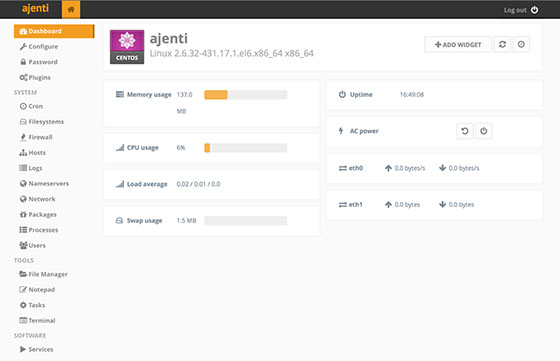
In this tutorial, we will show you how to install Ajenti Control Panel on CentOS 6. For those of you who didn’t know, Ajenti is a simple and easy-to-use admin panel that can be used to manage server tasks from any web browser a bit similar to the Webmin module. Ajenti is a much more powerful and lightweight tool, that provides a fast and responsive web interface for managing small server set-ups and is also best suitable for VPS or Dedicated servers. It has been built with many pre-made plugins for configuring and monitoring server software and services such as Apache, Cron, File System, Firewall, MySQL, Nginx, Munin, Samba, FTP, Squid, and many other tools like File Manager, Code Editor for developers and Terminal access.
This article assumes you have at least basic knowledge of Linux, know how to use the shell, and most importantly, you host your site on your own VPS. The installation is quite simple. I will show you the step-by-step installation Ajenti control panel on CentOS 6.
Prerequisites
- A server running one of the following operating systems: CentOS 6.
- It’s recommended that you use a fresh OS install to prevent any potential issues.
- SSH access to the server (or just open Terminal if you’re on a desktop).
- A
non-root sudo useror access to theroot user. We recommend acting as anon-root sudo user, however, as you can harm your system if you’re not careful when acting as the root.
Install Ajenti Control Panel on CentOS 6
Step 1. First, you need to enable the EPEL repository on your system.
## RHEL/CentOS 6 64-Bit ## # wget http://download.fedoraproject.org/pub/epel/6/x86_64/epel-release-6-8.noarch.rpm # rpm -ivh epel-release-6-8.noarch.rpm
## RHEL/CentOS 6 32-Bit ## # wget http://download.fedoraproject.org/pub/epel/6/i386/epel-release-6-8.noarch.rpm # rpm -ivh epel-release-6-8.noarch.rpm
Step 2. Download and Install Ajenti Control Panel on CentOS 6.
Now we install Ajenti’s official repository by using the following commands:
wget http://repo.ajenti.org/ajenti-repo-1.0-1.noarch.rpm rpm -i ajenti-repo-1.0-1.noarch.rpm
Run the following command to install Ajenti:
yum install ajenti -y
Install Ajenti-V with the packages according to your needs:
yum clean metadata yum install ajenti-v ajenti-v-nginx ajenti-v-mail ajenti-v-mysql ajenti-v-php-fpm php-mysql
Step 3. Start the Ajenti service.
service ajenti restart
Step 4. Configure Iptables or firewall your server.
iptables -A INPUT -p udp -m state --state NEW --dport 8000 -j ACCEPT iptables -A INPUT -p tcp -m state --state NEW --dport 8000 -j ACCEPT
Step 5. Access Ajenti Control Panel.
The Ajenti control panel will be available on HTTPS port 8000 by default. Open your favorite browser and navigate to https://your-domain.com:8000 or https://server-ip:8000 and enter the default username “admin” or “root” and the password is “admin“.

Congratulations! You have successfully installed Ajenti. Thanks for using this tutorial for installing the Ajenti control panel on CentOS 6 system on CentOS 6 systems. For additional help or useful information, we recommend you check the official Ajenti website.